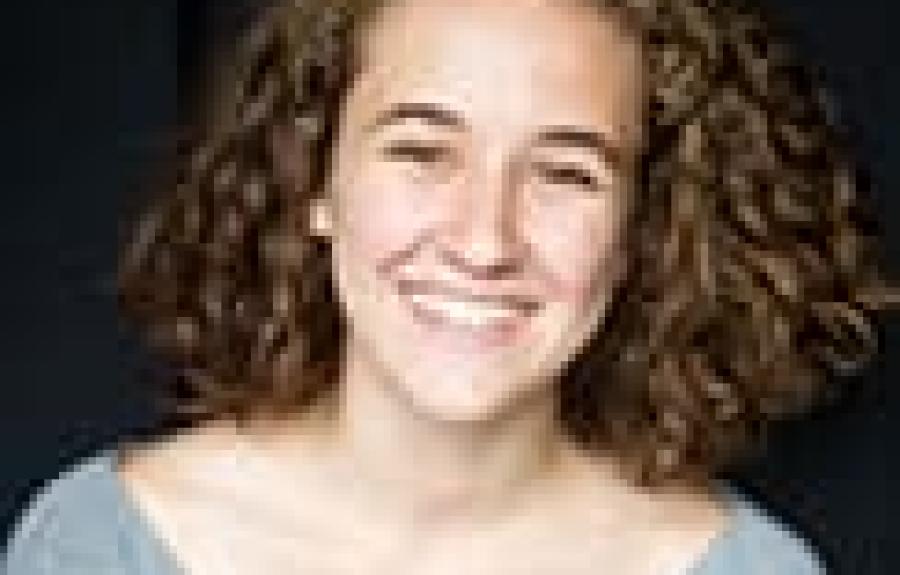Performance Details
The Department of Performing and Media Arts (PMA)
presents
Mini Locally Grown Dance
Directed and Choreographed by Jumay Chu and Byron Suber
December 3–5, 7:30 p.m.
Letter from the Chair
Dear community members,
In a more typical year, you would be reading this note in a physical program while gathering in a public space. As you well know, there is nothing typical about this year, and so this note must also depart from the conventions that have tended to govern it in the past. Ordinarily I might describe particular projects with confidence that they would materialize in ways of which we could be basically certain. But not now; the very digital program in which this note appears could change before the end of the semester—and could change even more dramatically for the coming spring.
Indeed, what we were intending as a year’s worth of programming in our immediately prior spring has already been radically reimagined. I am proud of students, staff, and faculty who have responded with inventiveness and imagination to making virtual work in socially distanced ways. I am proud that the majority of this work is centering perspectives on systemic racism and white supremacist ideology, of which the Department of Performing and Media Arts must take urgent stock, for which we must be accountable, and whose dismantling we must actively undertake. I am proud that numerous BIPOC guest artists and scholars will visit classes and make public presentations via Zoom. And I am proud that all of this activity is free to our publics, who now more than ever need access to art and intellection that we hope will sustain us through the anxieties and exhaustions of our current political and historical circumstances.
I look forward to a time when we may all convene again in the Schwartz Center for the Performing Arts and communally enjoy film, dance, theater, performance art, installation, public lectures, and more. In the meantime, I wish everyone reading this note physical health and emotional and spiritual well-being.
Letters from the Directors
As we look around, we feel time stealing away. Familiar habits of work, of friendship, of passing through the day recede further into the long months. We hold on to them, hopeful they will return, but we wonder nervously in what form. In dance, a viscerally collaborative way of being, we are thrown onto ourselves alone, suddenly without the kinesthetic support we depend upon. How does the dancer create by herself, imagine the space by herself, perform by herself?
Dance steals up on us. The fall semester began its vulnerable pace. The summer months had brought hot turbulence and rage, and now both the early autumn light and the uncertainty of classes distracted us from the turmoil of the preceding months. Atelier 320 began its work, each dancer in her private space reaching into the tumult of expression—the heat of protest, the cold of disbelief, the warmth of hope. What seemed endless disconnects at first began to find means of surprising connections and new significance. The members of Atelier 320 who have worked together before this semester are a group of extraordinary dancers who have created a safe and supportive community within which they can be cheeky, fearless, and daring in their choreographic imaginations—lifting, throwing, and catching each other; tumbling and rolling, slowly and briskly, tightly over each other; intimate and far-reaching. They are joyful to have new partners, but the challenge has been how to embrace each other, new and old, when each dancer is on her own and forced to remain isolated.
“Thieves” is the expression of many of these thoughts. In dancing alone, each dancer has had to find a new way of being meaningful in the work. As I watch each one create her or his solo, I can see the intelligence of the expressions being explored and the resources that are being questioned, and I admire the earnest rigor each has to the journey. In choreographing their solos, they are finding their own resilient strengths, the power of their imaginations, and finally, in the performance of “Thieves,” they are offering their discoveries to create a larger sense of themselves and of what the experience of dance can signify.
The final collaboration remains not with Atelier 320 alone but with new partners in the making of the video for Mini Locally Grown Dance. The bodily and emotional experience of dancing and watching dance is brought to the flat screen by the brilliant work and imagination of Steven Blasberg and Jeff Palmer. Steven was tireless in working with cameras, shooting dancers from exciting angles and with surprising moves. Amidst the storm of video footage, Jeff pulled disparate parts together and discovered an enthralling way of seeing the dance, rhythms of perspectives that I could never have possibly conceived. I am thrilled for the new way of seeing the dance that Steven and Jeff have revealed for me.
I am grateful, too, for the chance of working again with Powerdove, Annie Lewandowski’s band, and with Thomas Bonvalet. Their strangely beautiful and haunting music speaks eloquently to these times, and their music for “Thieves” is a prelude to our collaboration for next spring.
Collaboration in these uncertain times of distance is in a state of instability. But in a strange way, it remains steadfast for us in dance. The collaboration of Atelier 320 keeps me grounded, the collaborative crossings in PMA renew my faith, and my collaborative and precious intrigues with Byron steal me away.
—Jumay Chu
While finishing the spring semester in quarantine and online, we were assuming that we would be live again soon enough, at least by the end of the Fall semester, so we didn’t even begin considering a completely virtual performance until it became clear that would be an imperative. And at that point, we were looking to the spring semester to be live but that possibility also became an impossibility. Our frame of reference for making work always centered on the present moment, whether it be in rehearsal or performance. But our sensibilities of creating choreography face-to-face, in three dimensions, with video being only a peripheral component of a live performance, began to seismically shift. Our new demands on an audience required a different path for our creative imaginations, or perhaps it was realizing that an audience would be watching our work virtually and would have different demands on us as choreographers. But they would also have different ways of choosing to watch or not watch our work differently than being in an enclosed performance space. This de-centering was in some ways productive, albeit completely unsettling.
For many years, I had become increasingly used to depending on my performers for their contributions through extensive collaboration but this took those expectations to new levels. Working virtually, with each student having solitary access to a studio, required new processes and protocols. While it was refreshing to the students to be able to safely move expansively across an individual studio, there was an underlying heaviness suspended over our work. It had begun to develop in those last weeks of the spring semester with the students struggling to dance through the shock of moving from campus to their home environments. The undeniable pallor of sadness echoing what we were all going through, not just in our classrooms, but globally, brought a severity to the work that ached to be balanced with an elusive lightness. I found some of that lightness in my pandemic obsessive consumption of social media, particularly TikTok. While we drew inspiration from the small moments of joy in that medium, we filtered that lightness with the palpable distress we were all experiencing to make the work we are exhibiting this weekend.
After many weeks of developing individual solos, we filmed almost everything in one studio, divided now by a huge pliable plastic wall…but a few shots were captured in two of our other studios. For videography, each performer had to schedule specific times with not only me but also a friend with whom they shared a living space, or with whom they shared some sort of physical closeness…forming nine small separate quaranTEAMS. I would Zoom with each pair and direct the shots but could not see the product until it was uploaded. We ended up with close to 500 clips. With so much material, I was expecting only a small percentage to be usable, but in fact there was such incredible poignancy and intimacy in the work that I felt compelled to find ways to use as much of it as I could. This meant editing it all together in a way that made some poetic formal sense but it also produced some very long segments.
To resolve the issue of length, the product(s) you are viewing tonight are divided into three sections: the Eclipse I, II, and III, each section premiering on a different night. As we move into the spring semester and continue to develop the work, I am not sure where this will all lead as we transfer to a more formally produced video product with designed costumes, sets, and lights, but I see those future iterations as subsequent sections of what in the end will be a very large project.
For copyright reasons, since this will be on the open web, copyrighted music is not available to us but it gave us the opportunity to work with colleagues who improvised and wrote some excellent pieces. The piano solo music is all improvised by Syau-Cheng Lai, recorded in preparation for a different project in a session several years ago. I was ecstatic that she agreed to let us use this incredible work, as it has always meant a great deal to me. Warren Cross put together a couple of pieces of alternative pop music and some sound effects that gave the work an energy and tone that it desperately needed and would have been impossible otherwise. And finally, Max Buckholtz created some violin and viola variations from the Bach Chaconne that lent a balance to the work that is both dramatic and unsettling.
Lastly, I want to acknowledge an extended 30-year collaboration with my dear friend and colleague Jumay Chu that is in some ways coming to an end this year. Without Jumay, my work today would be seriously lacking in the ways in which I approach time and space in both my stage and video work, but also in how I understand the history of dance and also the ways in which I approach the world in my personal life. I am hoping to collaborate with her in the future both professionally and personally as she has been an undeniable treasure to me in too many ways to mention in this short letter. But if I can just say, Jumay, thank you for your friendship and professional guidance all these years and you will be greatly missed as my closest and most cherished colleague.
—Byron Suber
Tonight's Program
Let It Go
Directed by: Mariaenrica Giannuzzi
Written and produced by Soft Squadron. Mixed and mastered by Maro J. Kariya.
Choreographed in COVID-19 quarantine Spring 2020 by Dorian Chavez in Brussels and Mariaenrica Giannuzzi in Ithaca, New York.
Let It Go
the Eclipse
Thursday, Section 1; Friday, Section 2; Saturday, Section 3
Directed by: Byron Suber
Choreography: edgeofthegorge (created by Byron Suber, depending heavily on extensive collaboration with the performers)
Video and Sound Editor: Byron Suber
Videographers: Angelique Acevedo, Adriana Chandler, Hayden Garniewicz, Tadafe Gbaje, Caleb Harden, Molly Heck, Alexandria Kirby-Williams, Julia Lehman, Samantha Liu, Angelyn Loh, Madeline Silva, Holly Sullivan, Eileen Tzng, Kaitlyn Yeh
edgeofthegorge performers: Alexia Carey, Kaitlin Chang, Hayden Garniewicz, Johnna Lee, Timmy Ma, Hannah McManus, Bailey Regan Madeline Silva, Naomi Wang
the Eclipse
Section 1
Section 2
Section 3
Thieves
Directed by: Jumay Chu
Choreography: Atelier 320
Editor: Jeffrey Palmer
Cinematography: Steven Blasberg
Videography for Madeleine Lee: William Mun
Atelier 320 Dancers: Julia Barravecchio, Micaela Carroll, Mariaenrica Giannuzzi, Kate Harline, Bryeson Henry, Savannah Jeffries, Madeleine Lee, Destiny Nwafor, Bailey Regan
Thieves
Let It Go Company Profiles
Dorian Chavez is a dancer who doesn't know how to do bios—that is why he is constantly hiding. Actually, he is trying to become a curious phenomenon like dew, refraction, goose bumps, hiccups, and all the weird things that happen in the body when we think we could fall in love.
Mariaenrica Giannuzzi is a writing and language instructor and PhD candidate in German Studies at Cornell, where dance becomes an important part of her conceptual research.
Soft Squadron is Heather Fae Calla.
English Major Junior Fall form
English majors fill out the English Major Junior Fall form by the end of the first semester of their junior year. Students meet with their major advisor to complete the form, making sure they are on track to meet all requirements of the major by their anticipated graduation date.
Atelier 320 Company Profiles (Thieves)
Julia Barravecchio is currently a graduate student in the MPS in Management Program. She completed her undergraduate degree this past May at Cornell in the ILR School. During her undergraduate years, Julia was also active in PMA dance courses, in addition to her current Modern III. She is also a member of Pandora Dance Troupe and has been dancing throughout her life.
Thomas Bonvalet is a self-taught multi-instrumentalist. Having commenced his vocation as a bassist he cemented it as a guitarist at the heart of the band Cheval de Frise (1998–2004). Progressively straying from the guitar, he began to integrate foot tapping and various wind and percussive instruments into his performance, incorporating mechanical elements and stray amped-up objects into the soundscape. This formed the guiding principle of his solo project, L'ocelle mare, initiated in 2005, and continues to form the core of his instrumentation.
Micaela Carroll is a senior in Arts & Sciences, studying how we learn movement patterns. She hopes to apply what she learns to creating effective movement pedagogy in dance and martial arts classrooms. She's so happy to still be dancing this semester! She hopes you enjoy it.
Mariaenrica Giannuzzi is an Italian PhD candidate in German Studies at Cornell University.
Kate Harline is a fourth-year PhD candidate in Plant Biology. She has danced in LGD and MLGD since coming to Cornell. Other credits include: Washington University Dance Collective, Slaughter Project, Washington University Dance Theatre and Student Dance Showcase (director and performer). Kate is so grateful to Jumay for providing such a warm and inspiring environment to continue to practice what she loves these past four years.
Bryeson C. Henry is a senior majoring in English with a concentration in African American Studies and Literature. Born in Rochester, NY, his first official dance class was with Garth Fagan Dance, where he found the intricate dance movements particularly interesting. At Cornell, he has taken modern dance courses, culminating in his participation in the Fall 2019 MLGD concert. His favorite choreographer is Sonya, and when he is not dancing, he enjoys playing guitar and watching movies.
Savannah Jeffries is a first-year planning to major in math and minor in dance. She grew up in Virginia and has danced her entire life! She also absolutely loves working with three- to five-year-old dancers outside of her own classes and groups. Savannah is so excited to be joining Cornell’s dance family and is looking forward to participating in her first MLGD!
Madeleine Lee is a senior studying environmental engineering and minoring in dance. Her experience with LGD has spanned the performing side and the production side, as she has danced with Jumay since her freshman year and worked in the costume shop with Lisa Boquist and Sarah Bernstein. She'd like to credit her close friend William Mun with helping her shoot her solo. Madeleine is also inspired by musical artists like Joji. She hopes you enjoy the virtual presentation of MLGD!
Since 2007, Annie Lewandowski (voice/electronics) has been extending the limits of songwriting under the moniker Powerdove. In the Powerdove trio with Thomas Bonvalet (assorted instruments) and Chad Popple (percussion), stark melodies with pared-down lyrics are contrasted with a wide spectrum of surprising and delighting noise-making devices. Powerdove’s economical songs are experiments in freedom in fragments, the voice a lighthouse in the midst of an instrumental storm.
Powerdove has released several recordings, most recently “War Shapes” on Murailles Music (2017). They have performed at venues across the United States and Europe, including the End of the Road Festival (England), the Alan Lomax Festival (France), Musica Nelle Valli (Italy), Fanø Free Folk Festival (Denmark), and the Switchboard Music Festival (San Francisco).
Destiny Nwafor is a senior studying Computer Science with a PMA Dance minor. This is her second Mini Locally Grown Dance performance and she is thrilled to be able to produce and share work in a virtual world. Hope you enjoy!
Bailey Regan (also appearing in "Eclipse") is a senior in the College of Arts & Sciences. She is an English major and a Law & Society minor from Massachusetts. Bailey has been dancing since the age of three, beginning at a competitive dance studio then training at the Boston Ballet School’s North Shore Studio. She has also attended summer dance intensives at the Boston Ballet, ABT, and the Boston Conservatory. At Cornell, Bailey is the Vice President of Pandora Dance Troupe. This is her very first Mini Locally Grown Dance performance, and she is so grateful for the chance to work with Jumay and Byron and all of her fellow dancers, especially during this time of social distancing and irregularity. She is thankful that her PMA classes can be such a nurturing and engaging creative outlet for her at Cornell.
Director/Choreographer Profiles
Jumay Chu danced in companies in New York and Paris. In 1989 she joined the dance faculty at Cornell where she teaches dance technique, composition, choreography, and dance studies in PMA. She is currently working with her dancers of Atelier 320 choreographing for the next Locally Grown Dance concert in March 2021.
Byron Suber is originally from New Orleans, LA, and moved to Ithaca in 1991 after ten years of living and working in New York City. His work there included choreography, music, theatre, costume design, and performance art. His pieces have been exhibited at La MAMA Inc., Performance Space 122, the Kitchen, DANSPACE, the American Dance Festival, and The Wigstock music festival. He has collaborated with professors and graduate students from the MIT Media Lab on the development and use of digital wearables. Suber has received grants and awards from the Harkness Foundation, Art Matters Inc., New York Foundation for the Arts, and the Cornell Council for the Arts. He has taught at the American Dance Festival at Duke University, Dance Space and Steps, in NYC, as well as various universities in the United States and Europe.
Production Staff
| Director of Productions and Events | Pamela Lillard |
| Technical Director | Fritz Bernstein |
| Props Coordinator | Tim Ostrander |
| Costume Shop Supervisor | Lisa Boquist |
| Master Electrician | Steven Blasberg |
| Stage Manager | Howard Klein |
| Facilities Coordinator | Ted Romer |
| Computer Support | Chris Christensen |
| Communications Manager | Lindsey White |
| Communications and Events Coordinator | Youngsun Palmer |
| Box Office Manager | Julie Tibbits |










